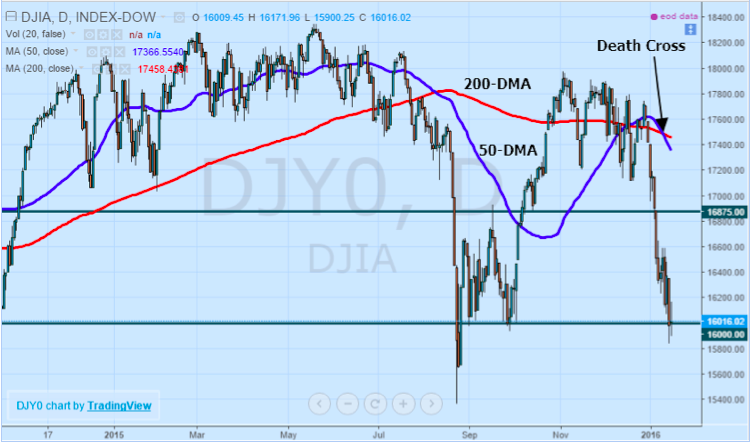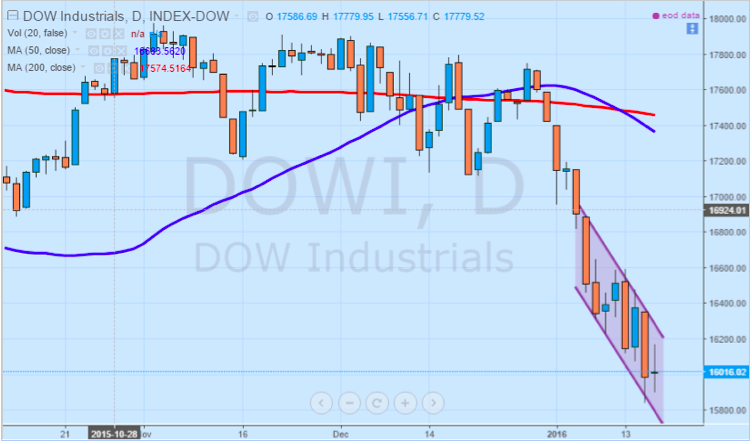Looking for any evidence that the market as a turning point? Look no further than the VIX index that tracks volatility in the S&P 500. With volatility rapidly on the rise globally, it is no wonder that US benchmarks remain sensitive to international developments. The Dow Jones Industrial Average has suffered one of the worst January performances on record as the rising threat of economic uncertainty across Asia damages investor confidence. Risk aversion signs are becoming increasingly abundant and fears of overextended valuations are coming to fruition as a selloff begins to grip markets with certain global benchmarks already in bear market territory. The Dow is unlikely to be immune from these forces despite the relative health of the US economy in relation to other advanced nations.
Rising Rates and Dollar Dent Outlook
Components of the Dow Jones Industrial Average have benefited from the generally rising tides of equity markets over the last 5 years as the extremely accommodative monetary policy environment combined with balance sheet expansion help engineer a substantial bull market in risk assets. Stocks were one of the biggest beneficiaries with benchmark gains echoing asset purchases under the quantitative easing program. However, now that accommodation has come to an end and rates have begun to rise, the balance sheet has stabilized and shrunk modestly, despite pledges by the Federal Reserve to reinvest principal upon maturity. With no growth and the rising possibility that the balance sheet will gradually be wound down, easy money that flooded equity markets has now dried up, with the tides slowly flowing out.
A byproduct of the move by the Central Bank to begin a period of so-called quantitative tightening is the momentum higher in the US dollar. During the years of quantitative easing, the dollar was depressed by a growing money supply, helping to make equity valuations of American multinationals more attractive on the basis of relative value and exchange rates. Now that the dollar has further tailwinds from expectations of continued tightening of policy, the move higher in the currency makes American stocks more expensive on a relative basis, reducing demand in lieu of more attractively valued assets. With momentum set to continue in-line with policy, a rising dollar means additional pressure on stocks at least over the medium-term.
The Revenue Recession
The tides are certainly turning for stocks, with 2015 starting to look largely like the year that equity markets put in tops from a technical perspective with volatility slowly on the march higher. Now that the fireworks have in the east with Chinese fortunes slowly shifting, global equities have begun to start more accurately reflecting global macroeconomic conditions. Recent data released from the US indicates similar trends, with consumption and manufacturing starting to show increased evidence of a broader slowdown. For Dow performance is largely in-line with recent year-end economic performance in the US combined with the ongoing revenue recession faced by many multinationals.
Stock buybacks have replaced capital expenditures as a vehicle for growth as firms cut costs to the bone amid stagnating revenue growth. Companies exhausted cheap borrowing conditions to finance additional repurchases over the near-term to provide shareholders with value, hardly a sustainable long-term business model. While the Dow Jones is not as overvalued on a historical basis in comparison to the S&P 500, a price-to-earnings ratio of 15.15 (as of January 15th) still implies that the index is modestly overpriced and quite due for a deeper correction after a spectacular 5-year bear market.
The Technical Take
After a spectacular uptrend, price action in the Dow Jones over the last year has been relatively range bound. Although the index reached new highs in 2015, those levels appear unlikely to be retested in the near-term barring any massive policy intervention from the Federal Reserve intended to stabilize valuations and provide shock therapy for markets. Looking at the key technical indicators, recent price action suggests that the Dow Jones is slightly oversold as evidenced by the relative strength index (RSI) trending near the key 30 level. While not at oversold as levels experienced back in August, it could suggest a short-term rebound higher. However, even if an upside pullback occurs, it does not change the prevailing trend lower.
The recent crossover of the 50-day moving average below the 200-day moving average is highly indicative of bearish pattern known as the “death cross” which is typically followed by substantial downside in a pair. Since occurring in the prior week, the Dow Jones has continued to trend lower, testing key support levels on the downside at 16,000 before a small bounce higher. The rebound may continue as a downward trending equidistant channel emerges in the pair, with short positions ideally established near the upper channel line targeting the lower channel line before retesting August lows near 15,400.
Why Watch
Now that the economic environment has taken a deeper turn both domestically in the US and externally, the pressure is on for Dow Jones Industrial Average components. As investors run for cover in haven assets, stocks are likely to bear the brunt of the losses. With the fundamental indications matching the predominantly bearish technical setups, the stage is set for additional downside in the Dow Jones Industrial Average stock index. While a near-term bounce higher is possible, this rally should ideally be faded with short positions unless the gain is the direct reaction to new monetary stimulus measures. However, with new stimulus unlikely to be forthcoming, the downside bias remains strong over the medium-term.
Read More:
How to buy low sell high ? (In forex and crypto)
Tradersdna is a leading digital and social media platform for traders and investors. Tradersdna offers premiere resources for trading and investing education, digital resources for personal finance, market analysis and free trading guides. More about TradersDNA Features: What Does It Take to Become an Aggressive Trader? | Everything You Need to Know About White Label Trading Software | Advantages of Automated Forex Trading







































